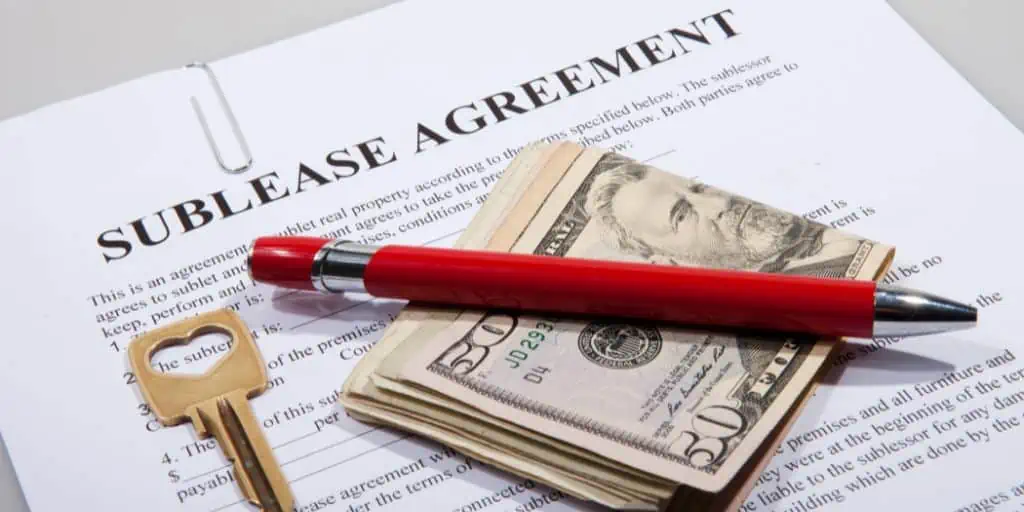What Is a Sublease?
REtipster does not provide legal advice. The information in this article can be impacted by many unique variables. Always consult with a qualified legal professional before taking action.
Shortcuts
- A sublease or sublet refers to an agreement where a tenant leases or rents out all or part of their rented property to another tenant.
- The original tenant becomes known as the sublessor and the second tenant the sublessee (or subtenant).
- In this scenario, the original tenant makes a new contract with a new renter to rent out the space, and the sublessee pays rent to the sublessor, who then pays the landlord.
- Provided they are legal and the landlord has expressed written consent, subleasing is a useful way to handle certain situations, such as reducing the rent the original tenant pays to the landlord (especially if the sublessor just rents out only a part of their rented space).
How a Sublease Works
A sublease is a deal where a tenant rents the property to another person, typically for the rest of the original lease period[1].
At its core, a sublease is a legal contract where an existing tenant rents out their rented property to a third party. The subtenant takes on the responsibilities of the original tenant, which may include paying rent and following the lease’s rules.
A sublease involves three main entities: the original tenant (sublessor), the subtenant or sublessee, and the landlord. The sublessor, while remaining a tenant to the landlord, becomes a pseudo-landlord to the subtenant.
In a sublease deal, the original tenant is responsible for meeting all the lease duties and covering any damage to the property. The landlord isn’t part of the sublease deal, so they can’t give any rights or put any duties on the new tenant except to stop the original tenant from subleasing the place.
That said, the landlord often needs to consent to the sublease to be valid, and the original lease agreement with the tenant can outline conditions and restrictions for subleasing. Some places also enforce this caveat. For example, a tenant who lives in a New York City apartment building with four or more units can only sublease the unit if the landlord gives written consent[2].
Why Would You Sublease a Rental?
Subleasing can happen for several reasons, such as sudden job relocations, unexpected financial struggles, or a desire for a change in a tenant’s living environment. Here are some specific use cases.
Job Relocation
Subleasing may also be better when the first tenant is moving out for a while and doesn’t want the extra hassle of keeping up with rent[3].
Imagine you’ve signed a year-long lease on an apartment, but your job suddenly relocates you to another city six months in. Instead of breaking your lease (which may incur penalties), you can sublease your apartment to someone else for the remaining six months.
Affording Higher Rent
In general, subleasing is a good choice if the first tenant wants to sublease just a part of the property. For instance, they may sublease a room and make some money from the sublessee’s rent if they have extra space. This extra money helps them cut down on the rent they pay the landlord.
Suppose you’ve found a two-bedroom apartment you love, but the rent is slightly out of your budget. You could sign the lease and then sublease the second bedroom to offset the cost, making the rent more affordable.
Temporary Lodging
Subleasing from a sublessor is a good idea if you’re only considering a short stay in an area but longer and more affordable than a hotel.
For example, consider a student who needs to stay near their university only during the academic year. They can sublease from a tenant who travels extensively and leaves their apartment empty for long stretches, providing a flexible and often cheaper alternative to a full-term lease.
Vacation Periods
Subleasing is also a practical option for those who have to leave their rented property for extended periods.
For instance, if you’re a teacher and plan to travel during the summer break, subleasing your apartment could help cover the rent during your absence.
How to Sublease a Rental
Subleasing a rental unit typically follows these steps:
- Talk to the landlord about your desire to sublease the place.
- Look for possible new renters. Finding a reliable and trustworthy[4] person is important, especially when subleasing.
- Check the applicants. Perform a thorough tenant screening by reviewing their references, running background and credit checks, etc. Use automation and software where applicable.
Without the landlord’s clear and written OK, the sublessor could be in trouble for breaking their lease agreement. The first tenant should also check their renter’s insurance policy for special rules for or against subleasing. This is extra important in subleasing deals since the first tenant is still on the hook if the property gets damaged.
Creating a Solid Sublease Agreement
Creating a well-written sublease agreement is crucial for a successful subleasing relationship. This document should include these four things:
- Sublease duration: Specify the sublease’s start and end dates. This eliminates ambiguity and sets clear expectations for all parties involved.
- Rent amount and payment structure: Stipulate the rent amount, when it’s due, and how it should be paid. Is it monthly, bi-weekly, or a lump sum upfront? These details should be explicitly stated to avoid confusion later on.
- Property maintenance: Define what parts of the property are included in the sublease, especially if it’s a shared space. Also, establish expectations for property care and maintenance. This helps protect against potential property damage disputes.
- Termination clauses: Every sublease agreement should specify conditions under which either party can terminate the sublease. Whether due to a breach of agreement, unforeseen circumstances, or changes in the primary lease, having this clause helps protect both the sublessor and the subtenant.
Pros and Cons of Subleasing
While subleasing holds the potential to be a beneficial arrangement for all parties, it’s also critical to be aware of the possible risks. Below, we further explore the pros and cons associated with subleasing.
Pros
- Financial relief for the sublessor: A significant advantage of subleasing for the original tenant, or sublessor, is the financial relief it can provide. If the sublessor needs to move temporarily or cannot afford the rent, subleasing allows them to cover their costs without breaking their lease agreement.
- Flexibility for the subtenant: Subtenants benefit from the flexibility of subleasing. They can secure a shorter-term housing solution without being tied down to a standard one-year lease agreement. This can be ideal for students, temporary job assignments, or people new to an area and exploring different neighborhoods before settling down.
- Reduced vacancy for the landlord: For landlords, subleasing can reduce the risk of having their property vacant for long periods. If the original tenant needs to vacate temporarily, finding a subtenant ensures that the property remains occupied, reducing potential losses.
Cons
- Potential legal complications: Subleases can sometimes result in legal complications. For example, if the subtenant fails to pay rent or causes damage, the sublessor may be liable to the landlord. If not properly addressed in the sublease agreement, such situations can lead to costly legal disputes.
- Unreliable subtenants: The reliability of the subtenant is often a significant concern for the sublessor. If the subtenant fails to pay rent on time, damages the property, or violates the lease agreement, the sublessor is typically held responsible.
- Lack of control for the landlord: Although subleasing can prevent vacancy, it might result in landlords having less control over who is living in their property. If the original tenant does not properly screen subtenants, this can lead to problems down the line, from property damage to violation of the lease terms.
Sublease vs. Relet
These two terms are sometimes conflated, but subleasing and reletting are completely different renting or leasing methods[5]. A sublease rents the property to another person, while a relet assigns the original lease agreement to another tenant, who agrees to pay all the bills from that point on.
A relet also voids the original lease agreement, thus releasing the original tenant from further obligations.
While misusing one or the other is unlikely to cause significant financial hardship (since what’s important is the original agreement’s terms and conditions)[6], it’s important to clarify what each term means in areas or contexts where distinguishing them can help.
To better understand these terms, it helps to put them side-by-side for a quick comparison.
| Sublease | Relet | |
| Rental agreement | Original tenant and new sublessee | Landlord and new tenant |
| Point of contact | Sublessee pays rent to the sublessor, who pays the landlord | New tenant pays landlord and takes over outstanding obligations from the old tenant |
| Expiration of agreement | Only valid for the duration of the original lease contract | New rental agreement; old agreement is irrelevant |
| Property responsibility | Original tenant is responsible | New tenant is responsible |
Note that subleasing and reletting agreements may apply to full or partial property rentals. Either way, the rules and responsibilities for the original tenant and new sublessee will remain the same, depending on the agreement.
Sources
- Sublease. (2021, April.) Legal Information Institute. Cornell Law School. Retrieved from https://www.law.cornell.edu/wex/sublease
- New York Consolidated Laws, Real Property Law – RPP § 226-b. Right to sublease or assign. (2021, January 1.). FindLaw. Retrieved from https://codes.findlaw.com/ny/real-property-law/rpp-sect-226-b.html
- The Do’s and Don’ts of Subleasing. (2023, April 14). Rocket Lawyer. Retrieved from https://www.rocketlawyer.com/real-estate/landlords/lease-amendments/legal-guide/the-dos-and-donts-of-subleasing
- Hemming-Metcalfe, S. (2018, November 15.) Trustworthiness is voted most important tenant trait by landlords. InventoryBase. Retrieved from https://inventorybase.co.uk/blog/trustworthiness-voted-important-tenant-trait-landlords/
- FindLaw Staff. (2021, November 23.) What is the Difference Between Subleasing and Reletting? FindLaw. Retrieved from https://www.findlaw.com/realestate/landlord-tenant-law/what-is-the-difference-between-subleasing-and-reletting.html
- Sublease Agreement. (n.d.) ContractsCounsel. Retrieved from https://www.contractscounsel.com/t/us/sublease-agreement









